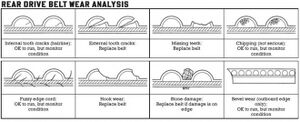Difference between revisions of "Drive Belt/Wear"
From Unofficial Zero Manual
BrianTRice (talk | contribs) (illustration) |
(No difference)
|
Latest revision as of 20:32, 8 July 2020
Generally, watch for belt damage and try to anticipate when to replace the belt to avoid an incident on the road where the belt snaps.
- What to Check
- Check the teeth for wear and cracks.
- If you see cracks in the tooth forming, the belt is getting old.
- If you see deep cracks starting, it's time to replace the belt ASAP.
- When to Replace
- When it snaps.
- When any teeth have been ground off.
- Hard Skips
- If the belt experiences a "hard skip" from debris between the belt and a sprocket, it is likely to fail soon after. Watch it carefully if this happens.
- Tension with aging
- Apparently, per forum user JaimeC, belts don't wear like chains.
- As they get older they'll actually get tighter, not looser like a chain.
- When a chain ages, the little bearing points between the links and rollers wear causing the chain to hang looser.
- When a belt ages, the rubber on the inner/toothed side begins to swell.
- Since the Kevlar belt on the outer circumference won't stretch, the inner circumference will shrink making the belt tighter around the sprockets.
- Generally, you want to make sure the belt hasn't gotten any tighter since you brought it home.
- References
